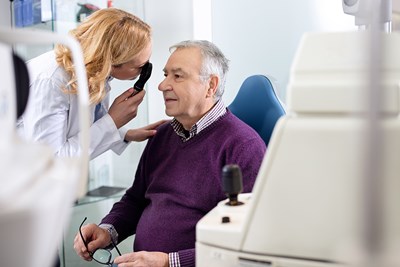Amblyopia is a condition in which the vision of one eye is not as strong as the other. It is often referred to as “lazy eye,” because the decreased ability of the eye causes it to wander in or out, giving it the semblance of lazy muscles. Here’s a look at the cause, symptoms, diagnosis, and treatment of amblyopia.
Causes of Amblyopia
Amblyopia develops as the nerves between the affected eye and the visual center of the brain fail to communicate as effectively as the other eye. The brain slowly pays less attention to the weaker eye so the eyes stop seeing in unison well, and eventually the brain barely notices input from the affected eye. Amblyopia generally develops before the age of 7, a common cause of decreased vision in one eye among children.
The most common cause of amblyopia is strabismus, which is essentially an issue with the muscles of the eyes. Generally, strabismus is combined with refractive anisometropia, a form of near or farsightedness in which the two eyes have wildly different prescriptions. One eye is weaker both visually and muscularly so the brain pays more attention to the stronger eye, leaving the weaker eye to wander. If one eye has a problem, such as a cataract, it interferes intensely with vision, which can lead to amblyopia without prompt treatment.
Symptoms of Amblyopia
One of the more obvious symptoms of lazy eye is, in fact, the laziness of the eye. While one eye focuses the other eye tends to drift inward or outward. It can be easy to mistake the weak eye muscles of newborns as the beginnings of amblyopia or strabismus, but most infants’ eyes develop normally. Even if there is not an obvious misalignment, the eyes may not work perfectly in tandem. Other issues that may arise from the eyes' inability to work together include poor depth perception.
Common signs to look for in children are squinting or closing one eye while looking at something or tilting their head. Headaches may develop from concentrating to see. Eventually, without treatment, amblyopia may lead to complete vision loss in the affected eye.
Diagnosing Amblyopia
In many instances, amblyopia is not obvious from the way the eyes move or do not move. In fact, an abnormal result on an early vision screening may be the only way to catch it. As such, the American Optometric Association (AOA) recommends screenings at six months, three years, and five to six years. An exam includes ensuring the general health of the eye, refractive testing for near- or farsightedness, seeing if the eyes wander, and the eyes will be dilated.
Treatments for Amblyopia
Beginning treatment while the eye’s connections to the brain are still forming can be much more successful than later treatment. In some instances, simply wearing the proper corrective lenses can fix refractive errors causing amblyopia. Another option is for the child to wear an eye patch over the stronger eye, forcing the brain to utilize the weaker eye. Alternatives to this are the Bangerter filter used with the child’s glasses, making the stronger eye see things fuzzier and atropine eye drops used twice a week.
Activities and exercises used in combination with these proven treatments may also increase the chances of success. According to the Mayo Clinic, treatments may be effective in as few as six months or as long as two years. Surgery may be necessary in more difficult cases, particularly if cataracts are involved. If you suspect your child has amblyopia, talk to an eye doctor as soon as possible.



